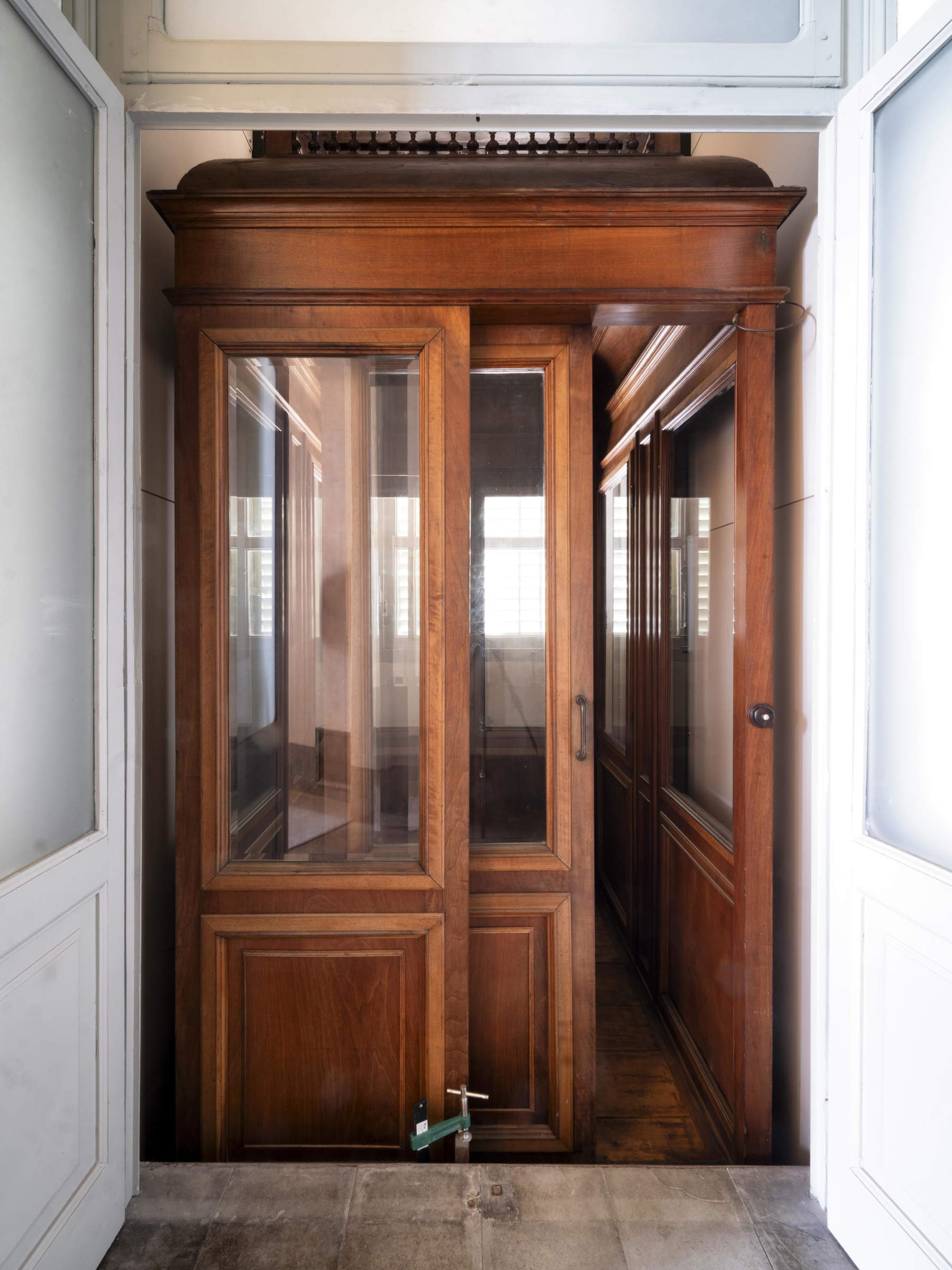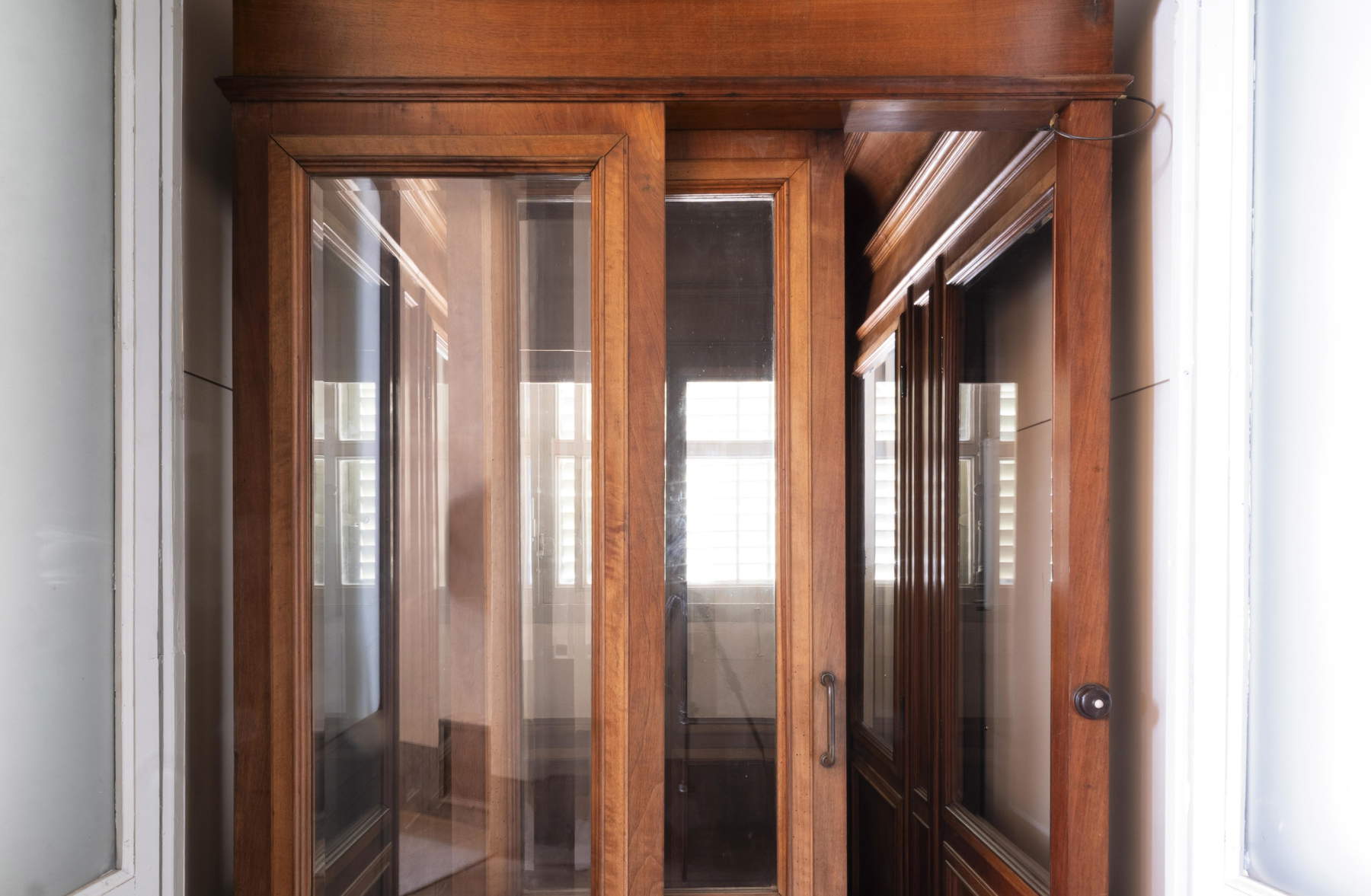The historic elevator used in the early 20th century by Queen Margherita at the Palazzina di Caccia di Stupinigi has been restored and now becomes part of the tour route. It is a period artifact, referred to in documents of the period as a “modern find of industry.” In those years, the residence was inhabited by Queen Margherita of Savoy, the first queen of Italy, widow of King Umberto I, together with her court.
The elevator, manufactured around 1905 by Officine Meccaniche Stigler of Turin, was intended exclusively for access to the second floor, where the residential apartments of the queen’s court were located. At that time, Queen Margaret resided in the Levante apartment, while her lady-in-waiting, Marquise Paola Pes di Villamarina, occupied the King’s Apartment. The installation of the elevator was part of the modernization work desired by the queen, who had transformed the Palazzina di Stupinigi into one of her favorite residences. Between 1902 and 1915, in fact, the building was equipped with numerous comforts: an upgraded heating system, “English-style” toilets with running water, sinks with hot and cold water, electric current, and an elevator. The latter operated by a hydraulic pump mechanism, had a wooden cabin equipped with a sliding door, windows with frosted glass panes, a bakelite control panel (of which only fragments remain today), and a top decorated with small turned balusters. Although its use was limited in time, it was later employed by the staff of the Museum of Art, History and Furniture after the Palazzina was converted into a museum in 1919.
The restoration was carried out by the La Venaria Reale Conservation and Restoration Center, thanks to a grant from the CRT Foundation.
The restoration provided an opportunity to deepen historical knowledge of the elevator through archival research and comparison with the successors of the historic Stigler mechanical workshops, the Turin-based firm Codebò. The investigation was conducted by Stefania De Blasi, an art historian and head of the Documentation and Communication Area of the “La Venaria Reale” Conservation and Restoration Center.
Of the elevator, only the wooden cabin had been preserved: the electrical and “water pump” instrumentation had been lost. The elevator shaft had been isolated from the basement, once home to the facilities, and the upper floor by partitions built in the second half of the twentieth century. Although some parts of the interior had deteriorated, the cabin still retained its two access doors and original glass panes. The interior was illuminated, although the original push-button panel was no longer present. This restoration work also allowed a methodological comparison with other similar cases involving historic elevators in Savoy residences, such as the one in Moncalieri Castle.
The intervention involved the consolidation of the poplar wood structure and the restoration of the walnut veneer, compromised by detachments and deformations caused by humidity. The cupola, decorated with baluster motifs, had numerous gaps that were reintegrated. Scientific analyses made it possible to identify the protective varnishes and to identify the most suitable techniques to ensure the stability and preservation of the artifact over time. The restoration was carried out by the Wooden Furniture Laboratory of the “La Venaria Reale” Conservation and Restoration Center, coordinated by Paolo Luciani with Andrea Minì, Francesca Coccolo, Lorenzo Dutto, Roberta Capezio, Michela Spagnolo and Valentina Tasso. Technical direction was entrusted to Michela Cardinali, and high supervision by Massimiliano Caldera, art historian official of the Superintendence for the Metropolitan Area of Turin.

“The inclusion of the restored elevator in the tour route of the Palazzina di Caccia di Stupinigi,” commented FOM President Licia Mattioli, “represents another step forward in the enhancement of the site. It is the first piece of interventions that will soon lead to an enrichment and expansion of the entire museum itinerary. Thanks to the contribution of the CRT Foundation and collaboration with the La Venaria Reale Conservation and Restoration Center, we can return to the public a unique artifact, a testament to innovation and attention to detail. It is a concrete example of how synergies between entities lead to significant results for the protection and enjoyment of our heritage.”
“The inauguration of the restoration of the historic elevator at Stupinigi is another step in the now 20-year collaboration between the Fondazione Ordine Mauriziano and Centro Conservazione e Restauro La Venaria Reale,” said Alfonso Frugis, president of CCR. “Together we work on defining conservation protocols and finding funds to support them. The elevator project is one such case for which, thanks to the opportunity to participate in the Fondazione CRT’s Cantieri Diffusi Call for Proposals, we can put into practice virtuous collaborations, which today are also manifested with the technical support from CCR to the candidacy of restoration projects for assets of the Palazzina di Stupinigi in the Art Bonus platform of the Ministry of Culture.”
“We are happy to have contributed to the restoration of such a rare and precious artifact as the Queen Margherita elevator, which is now returned to the community,” said Anna Maria Poggi, president of Fondazione CRT. “This expands the visiting path for the public, who will be able to appreciate an additional space of this 18th-century jewel, the result of Juvarrian genius, for which Fondazione CRT has historically been the main private supporter: an extraordinary asset not only from an architectural point of view, but also from an artistic one, thanks to the unique decorations and furnishings. Supporting culture, preservation and enhancement of artistic and architectural heritage is an integral part of the mission of Fondazione CRT, which has always accompanied the growth of the territory also through the revival of its cultural heritage.”
 |
| Stupinigi, historic elevator restored, the "modern industry find" wanted by Queen Margaret |
Warning: the translation into English of the original Italian article was created using automatic tools. We undertake to review all articles, but we do not guarantee the total absence of inaccuracies in the translation due to the program. You can find the original by clicking on the ITA button. If you find any mistake,please contact us.